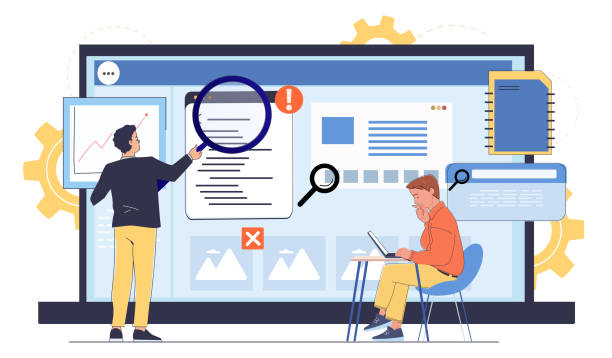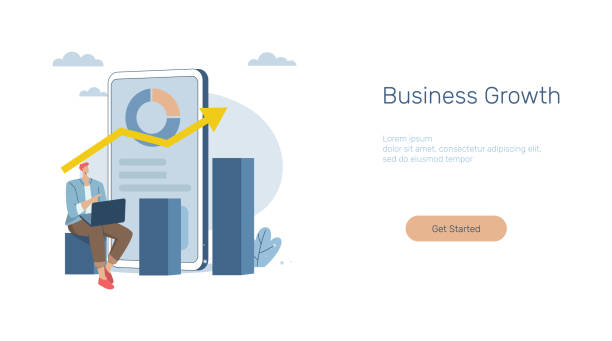Introduction to the Growing Need for Multilingual Website Design

In today’s world, where geographical borders have less meaning in the virtual space, #global_access and #communication with culturally and linguistically diverse audiences have become one of the most important goals for businesses and organizations.
One can no longer expect to attract a maximum number of customers and users by relying on a single language.
Multilingual website design is a response to this growing need; an approach that allows you to present your content in various languages, thereby significantly expanding your reach.
This process is not limited to simple translation, but requires a deep understanding of cultural differences, international SEO standards, and localized user experience.
A website is not just an information tool, but a bridge to connect with the world, and this bridge must be passable in various languages.
The importance of this approach becomes clearer when we know that a large portion of internet users do not have English as their native language and prefer to consume content in their own language.
This is an explanation of why it is essential to seriously enter the field of multilingual web development.
Are you annoyed by losing customers due to your online store’s outdated appearance or slow speed? RasaWeb’s expert team solves these problems with professional e-commerce website design!
✅ Increase customer trust and your brand’s credibility
✅ Stunning speed and excellent user experience
Get a free consultation with RasaWeb now ⚡
Benefits of Having a Multilingual Website for Business Growth

Having a multilingual website is more than a luxury option; it is a strategic investment for your sustainable business growth.
Among its most important advantages is increased access to global markets.
By providing content in various languages, you can reach potential customers in different countries who would otherwise never be aware of your presence.
This directly leads to increased website traffic and, consequently, an increase in conversion rates and sales.
Furthermore, a multilingual website demonstrates the credibility and professionalism of your business.
It shows that you care about your customers worldwide and are willing to invest in their convenience.
In the context of SEO, multilingual websites can achieve better rankings in search engines for different keywords and in various languages.
This means greater visibility and attracting more targeted customers.
From an analytical perspective, traffic data from different linguistic regions can provide valuable insights into new markets and growth opportunities.
This approach not only makes multilingual website design essential but also transforms it into a smart strategy for international competition.
Increased customer satisfaction through providing content in their native language is another significant advantage that greatly contributes to customer loyalty and brand strengthening.
Choosing the Right Strategy for Multilingual Website Design

Choosing the right strategy for implementing a multilingual website is one of the most important steps in the multilingual website design process.
This choice directly impacts the technical structure, user experience, and search engine optimization.
There are several methods for this purpose, each with its own advantages and disadvantages.
The most common approaches include using country code top-level domains (ccTLDs) such as `example.de` for Germany, subdomains like `de.example.com`, and subdirectories such as `example.com/de/`.
Proper guidance at this stage can prevent future problems.
For example, ccTLDs are very strong for local SEO but require managing multiple separate domains.
Subdomains offer good flexibility and are easier to manage than ccTLDs.
Subdirectories are often the simplest implementation method and inherently benefit from the authority of the main domain.
The choice of these strategies should be made considering business goals, budget, and the technical capabilities of the team.
In addition to these, attention should be paid to how user language is detected (based on IP, browser settings, or manual selection) and also to the use of `hreflang` tags to guide search engines about different language versions.
These technical decisions lay the foundation for a successful multilingual website design.
| Strategy | Address Example | Advantages | Disadvantages |
|---|---|---|---|
| Country Code Top-Level Domains (ccTLDs) | example.de | Best for local SEO, clear separation of geographical regions | High cost, managing multiple domains, need for separate infrastructure |
| Subdomains | de.example.com | Easier to manage than ccTLDs, good separation, scalable | Less local SEO power than ccTLDs, may require more DNS settings |
| Subdirectories | example.com/de/ | Simplest to implement, benefits from main domain authority, lower cost | Google might find it slightly more complex to understand local structure |
Technical Considerations in Multilingual Website Design Implementation

Technical considerations play a vital role in implementing a multilingual website design.
Choosing the right platform, database management methods, and technical solutions for switching between languages are among these.
Using Content Management Systems (CMS) like WordPress with multilingual plugins (such as WPML or Polylang), or using custom systems designed for this purpose from the outset, are available options.
It is important that URL structures are designed to be understandable and optimized for both users and search engines.
As previously mentioned, the use of the `hreflang` tag in the `
In addition, website loading speed in different languages is also important.
The server should be optimized to deliver content quickly to users in various geographical regions.
Using a CDN (Content Delivery Network) can be helpful in this regard.
From a coding perspective, it must be ensured that all text strings, images, audio and video files, and even texts within JavaScript are translatable and localizable.
This requires deep technical expertise to prevent display or performance issues in different languages.
Multilingual website design requires attention to details that improve user experience in each language and ensure technical optimization.
How much does losing business leads due to an unprofessional website cost you? With professional corporate website design by RasaWeb, solve this problem forever!
✅ Increase credibility and trust of potential customers
✅ Easier acquisition of new business leads
⚡ Get a free consultation now!
The Importance of Accurate Content Translation and Localization

In the process of multilingual website design, content translation goes beyond a simple word-for-word change from one language to another; it is a localization process.
Localization means adapting content to the culture, values, idioms, and even local laws of the target audience.
A machine or unprofessional translation can severely damage your brand’s credibility and even lead to cultural misunderstandings.
For example, a slang term in one language might have a completely different or even offensive meaning in another.
Therefore, using native and specialized translators in your field of activity is crucial.
These translators not only have complete mastery of the language but are also familiar with the culture and specific details of the target market.
They can convey the desired tone, style, and even humor in the target language.
This is an instruction that shows why translation and localization should be regarded as an inseparable and sensitive part of multilingual website design.
In addition to text, attention should be paid to the translation and localization of images, currency, dates, phone number formats, and even text direction (such as right-to-left for Persian and Arabic).
This level of precision improves the user experience and gives the audience the feeling that the website was specifically designed for them.
SEO Optimization for Multilingual Websites

SEO optimization for multilingual websites is one of the most complex yet crucial aspects of multilingual website design.
The goal is for search engines to correctly identify the different language versions of your site and display them to the appropriate users in search results.
As mentioned earlier, the correct use of the `hreflang` tag in the HTML header or in the XML sitemap is very important.
This tag tells Google and other search engines which page is in what language and for which geographical region it is intended.
Furthermore, each language version must have its own high-quality and unique content.
Simply translating words without considering local keywords and common search phrases in that specific language harms SEO.
There is a need for keyword analysis for each language and their localization.
Also, the internal linking structure should be designed so that it is accessible from one language version to others.
Acquiring high-quality backlinks from local sites in each language also helps the site’s credibility and ranking.
All these specialized aspects of SEO must be considered from the very beginning of the multilingual website design process to prevent serious problems in the future and ensure that each language version performs optimally independently in search engines.
Popular Tools and Platforms for Multilingual Website Design

For the successful implementation of multilingual website design, choosing the right tools and platforms is of paramount importance.
These tools can help you manage translations, maintain site structure, and ensure a smooth user experience.
The most popular solutions are usually offered as plugins or modules for common Content Management Systems, although dedicated platforms also exist.
WordPress, as one of the most popular CMSs globally, supports powerful plugins like WPML (WordPress Multilingual Plugin) and Polylang for implementing multilingual capabilities.
WPML is a comprehensive and powerful solution that allows the translation of almost every part of the site, including posts, pages, categories, tags, and even menus.
Polylang is a lighter and free option suitable for smaller projects.
Similar plugins exist for other systems like Joomla or Drupal.
E-commerce platforms like Shopify also have built-in multilingual capabilities or offer them through third-party applications.
This is an explanation of the wide range of available options that allow teams to choose the best solution according to their needs and budget.
| Tool/Plugin | Type | Main Features | Notes |
|---|---|---|---|
| WPML | Paid (Premium) | Complete content translation, advanced translation tools, high compatibility with themes and plugins, multilingual SEO support | Can be somewhat heavy, requires technical familiarity |
| Polylang | Free (also has a Pro version) | Easy management of post and page translation, hreflang support, lightweight and fast | Some advanced features are limited in the free version |
| GTranslate | Free/Paid | Machine translation with manual translation option, domain and subdomain support for SEO | Machine translation is not always accurate, free version has limitations |
Challenges and Solutions in Managing Multilingual Websites

Managing a multilingual website, despite its many advantages, also comes with challenges.
One of the main challenges is maintaining content consistency and integrity across all languages.
With the addition of new languages, content may become fragmented, or updates in one language may be forgotten in others.
This can lead to inaccurate information or a poor user experience.
The solution is to create a comprehensive and systematic content management process that includes checklists, translation management tools, and a dedicated team to oversee content.
Another challenge is more complex SEO optimization.
Each language version requires its own specific local SEO strategy, which in turn necessitates separate keyword research and local link-building.
This questionable content regarding resource allocation for each language requires a precise strategy.
Multilingual website design means managing several small sites within a larger ecosystem.
Costs are another challenge; professional translation, technical development, and maintenance of a multilingual site can be expensive.
Careful budget planning and selecting scalable solutions are essential.
Technical issues related to compatibility with themes and plugins, as well as managing customer support in different languages, are other matters that need to be anticipated and addressed with solutions.
Are you concerned about your online store’s low conversion rate and not achieving your desired sales?
RasaWeb is your specialized solution for a successful e-commerce website.
✅ Significant increase in conversion rates and sales
✅ Professional and user-friendly design to attract customer satisfaction
⚡ Ready for a transformation in online sales? Get a free consultation!
Successful Examples and the Future of Multilingual Website Design

By looking at successful global examples, one can understand the high importance and potential of multilingual website design.
Companies like Google, Amazon, and Alibaba have all managed to penetrate global markets and become international business giants by offering services and content in multiple languages.
Even smaller businesses have seen significant growth in their sales and branding by investing in this approach.
This is good news for all businesses that dream of going global.
The future of multilingual website design also looks bright.
With advancements in artificial intelligence and machine translation, the localization process may become simpler and faster in the future, although the need for human intervention to ensure cultural accuracy and tone will remain.
The emergence of new technologies such as virtual and augmented reality will also intensify the need for localized content.
Websites are moving towards greater personalization and offering exceptionally local experiences.
This is an entertaining and exciting outlook that shows how language can be a bridge for global communications.
Investing in multilingual website design is considered a necessity not only for the present but also for the future of businesses.
Conclusion and Next Steps in Multilingual Website Design

In conclusion, it can be stated that multilingual website design is a powerful and essential strategy for any business or organization seeking to expand its reach and access global audiences.
This process not only leads to increased traffic and sales but also enhances brand credibility and significantly improves the user experience for non-English speaking audiences.
For beginning, your next steps should include the following:
- Research and Planning: First, identify your target markets and required languages.
Choose an addressing strategy (subdirectory, subdomain, or ccTLD) based on your SEO goals and budget. - Choosing the Right Platform and Tools: Based on your current CMS or future plans, select the best multilingual plugin or solution.
- Focus on Professional Translation and Localization: Use native and specialized translators to ensure that the content is not only translated but also localized.
- Implementing International SEO: Correctly implement `hreflang` tags and develop local SEO strategies for each language.
- Continuous Management and Maintenance: Establish regular processes for content updates, technical error resolution, and SEO performance monitoring.
This comprehensive guide provides a clear path for entering the world of multilingual website design and benefiting from its countless opportunities.
With careful planning and correct execution, your website can become a powerful tool for connecting with the world.
Frequently Asked Questions
| Question | Answer |
|---|---|
| 1. What is multilingual website design? | The process of creating a website whose content is available in multiple languages so that users from around the world can interact with the site in their own language. |
| 2. Why should we make our site multilingual? | To expand the market, attract international audiences, improve SEO in global search results, and increase brand credibility and professionalism. |
| 3. What are the methods for implementing a multilingual site? | Using subdomains (e.g., fa.example.com), subdirectories (e.g., example.com/fa/), URL parameters (e.g., example.com?lang=fa), or country domains (e.g., .ir, .de). |
| 4. Is multilingual site SEO different? | Yes, it requires international SEO strategies such as using the hreflang tag, appropriate URL structure for each language, and keyword research for each language. |
| 5. What points should be considered when choosing languages? | Language selection should be based on target markets, audience demographics, and current website traffic analysis data. |
| 6. What are common problems in multilingual website design? | Problems related to SEO, translation quality, content management, support for Right-to-Left (RTL) and Left-to-Right (LTR), and user experience. |
| 7. What is the role of CMS in multilingual sites? | Modern Content Management Systems (CMS) (such as WordPress with multilingual plugins or Drupal) offer built-in features or powerful plugins for easy content management in multiple languages. |
| 8. How should content translation be done? | Translation should be done by native and professional translators, not just machine translation, to ensure cultural tone, nuances, and local idioms are observed. |
| 9. How is language switching done on multilingual sites? | Typically, a Language Switcher is used in the site’s header or footer, allowing users to easily select their desired language. |
| 10. Is responsive design important for a multilingual site? | Yes, responsive design ensures that the site is displayed correctly on any device (mobile, tablet, desktop), which is vital for international user access and SEO. |
And other services of RasaWeb Advertising Agency in the field of advertising
Smart Reportage: An innovative platform for improving SEO ranking using real data.
Smart Website Development: A fast and efficient solution for increasing website traffic with a focus on attractive UI design.
Smart SEO: A fast and efficient solution for online growth with a focus on precise audience targeting.
Smart Google Ads: Designed for businesses seeking to increase website traffic through custom programming.
Smart Link Building: A dedicated service for growth in customer acquisition based on optimizing key pages.
And over hundreds of other services in the field of internet advertising, advertising consultation, and organizational solutions
Internet Advertising | Advertising Strategy | Advertorial
Sources
Multilingual Website Design and Its Benefits
The Importance of Multilingual Website Design
Multilingual Website Design Guide
Creating a Multilingual Website
? Let your business shine in the digital world with RasaWeb Afarin Digital Marketing Agency. We empower your digital identity by providing comprehensive services, including corporate website design.
📍 Tehran, Mirdamad Street, next to Bank Markazi, Kazeroun Jonoubi Alley, Ramin Alley, No. 6

